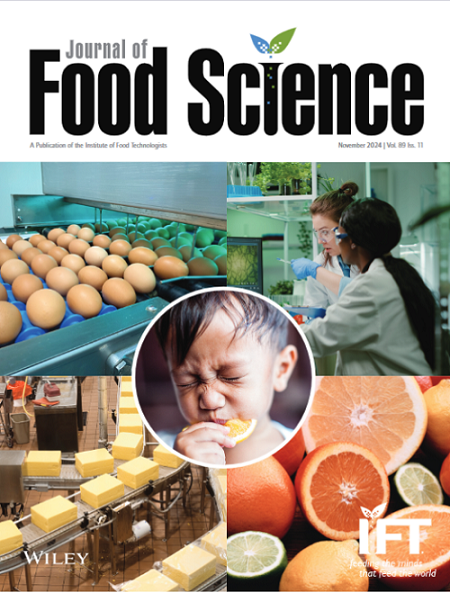The Influence of Combining Zinc Oxide Nanoparticles and Glycerol Monostearate for Stabilizing Two Different Water-In-Oil Pickering Emulsions
Abstract
ABSTRACT
This study examined whether glycerol monostearate (GMS) can mimic the role of diacylglycerol (DAG) as a co-emulsifier by evaluating the combined effects of zinc oxide nanoparticles (ZnO-NPs) and GMS on the stability of water-in-oil Pickering emulsions (PEs) through the evaluation of their physical and chemical properties. Two formulations were tested: red palm oil (RPO)-based PEs (70% oil, 1% GMS, 0.5%–1% ZnO-NPs) and soybean oil (SO)-based PEs (70% oil, 3% GMS, 0.5%–1% ZnO-NPs). During 14 days of storage, all PEs darkened, with increased free fatty acids (0.21–0.25 to 0.35–1.12 mg/g), carotenoid degradation (63.97–467.26 to 15.15–382.87 ppm), and decreased water activity (0.9648–0.9726 to 0.9552–0.9674). Rheological analysis revealed shear-thinning behavior (n = 0.7), increased hysteresis area (6.97–21.29 to 9.40–24.86 Pa/s), decreased three-interval thixotropy test (3ITT) values for RPO-based PEs (55.62–70.46 to 51.90–48.50%), but increased 3ITT values for SO-based PEs (37.14–50.33 to 46%–70%). All emulsions exhibited a linear viscoelastic region below 1% strain and a damping factor (tan δ) ≪ 1, indicating solid-like behavior. Thermal analysis revealed shifts in crystallization (–22.85 to –18.93°C) and melting temperatures (–0.25°C to 0.3°C). FTIR spectra exhibited peaks at 3039, 2920, 2852, and 1744 cm−1, with increasing transmittance at 3039 cm−1 over time. These findings suggest GMS and ZnO-NPs contribute to PE stabilization, though their synergistic effect appears limited.
Practical Applications
This study explores the combination of glycerol monostearate (GMS) and zinc oxide nanoparticles (ZnO-NPs) in stabilizing water-in-oil (W/O) Pickering emulsions (PEs), addressing the lack of insight into their potential synergistic effects. W/O emulsions are particularly relevant in the formulation of lipid-based delivery systems for hydrophilic bioactives in functional foods. By enhancing emulsion stability and texture, this system shows promise for improving the protection, controlled release, and shelf life of sensitive compounds in products such as spreads, sauces, dressings, and nutraceutical emulsions.





 求助内容:
求助内容: 应助结果提醒方式:
应助结果提醒方式:


